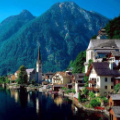Hallstatt, Austria Hallstatt is known as one of the most beautiful lakeside holiday resorts world-wide. Until the late 19th century, it was only possible to reach Hallstatt by boat or via narrow trails. The land between the lake and mountains was sparse, and the town itself exhausted every free patch of it. Access between houses on the river bank was by boat or over the upper path , a small corridor passing through attics. The first road to Hallstatt was only built in 1890, along the west shore, partially by rock blasting.
However this secluded and inhospitable landscape nevertheless counts as one of the first places of human settlement owing to the rich sources of natural salt, which have been mined for thousands of years, originally in the shape of hearts. Some of Hallstatt's oldest archaeological finds, such as a shoe-last celt, date back to around 5000 BC. In 1846 a large prehistoric cemetery was discovered close by the current location of Hallstatt. In addition, one of the first blacksmith sites was excavated there. Active trade and thus wealth allowed for the development of a highly-developed culture, which, after findings in the Salzberghochtal, was named Hallstatt culture. This lasted from approximately 800 to 400 BC, and now the town's name is recognised world wide. No notable events took place during Roman rule or the early Middle Ages. In 1311, Hallstatt became a market town, a sign that it had not lost its economic value. Today, apart from salt production, which since 1595 is transported for 40 kilometers from Hallstatt to Ebensee via a brine pipeline, tourism plays a major factor in the town's economic life. Tourists are told that Hallstatt is the site of "the world's oldest pipeline", which was constructed 400 years ago from 13,000 hollowed out trees There is so little place for cemeteries that every ten years bones are exhumed and removed into an ossuary, to make room for new burials. A collection of elaborately decorated medieval skulls with the owners' names, professions, and death dates inscribed on them is on display at the local chapel. The following are some popular tourist attractions : Hallstatt's association with salt mining dates back at least 7000 years and the ancient salt mine, which is known to have been in operation for 2800 years, is open to visitors. There are exhibitions devoted to archaeological and historical aspects of salt production from the earliest times up to the present. The mine still has its long, steep wooden slides, used by the miners to descend into the workings, which visitors can ride on. Deep in the mine, in the Hörnerwerk, there is a huge underground salt lake.
The bone house The bone house in Hallstatt dates back to twelve century AC. There are over 1200 skulls in the charnel, of them 610 have been painted in flowery designs, and they are neatly stacked in rows and have the date of death written on them.
Since the cemetery is so small without the possibility to expand and, due to the fact that cremations were in former days forbidden, there was just not enough space. The graves were opened 10 - 15 years later and the skulls were removed along sometimes with other bones. The skull was cleaned and exposed to the sun and moon light for weeks until they were bleached ivory white. As one would decorate a grave with flowers, the skulls were painted symbolically with a crown of flowers. This tradition began in 1720 AD. The last skull to go into the Bone house was in 1995.
The Catholic parish church and the cemetery The catholic parish church in Hallstatt is a beautiful gem in the midst of the world cultural heritage village. the small Roman church dates back to 1181. Its powerful tower dating back to the 12th century bears witness to this fact. Daringly built in the late Gothic times high up on a rock with a steep drop, it finally became in 1505 the existing church of today. Shortly after, the church became the centre of the fight for faith and was, for a while, protestant. It always remained, however, a gem in the heart of all the salt miners and wealthy salt mine lords from Salzburg, in the market square or in the yard. Since 1939 the maintenance of this gem has been in the hands of the small church community along with friends and visitors.In the year 2002 the catholic parish church was completely renovated.
The cemetary The rocky grounds of the parish church became the Hallstatt cemetery. The front is assigned the Evangelist Christians. Following the rules of the cemetery there are no family graves. A grave can be re-occupied after ten years. The dead are buried horizontally; the grave verge covers only a small part of the grave. Above the graves is the sign of Christ, a cross, made of wood or wrought steel.

